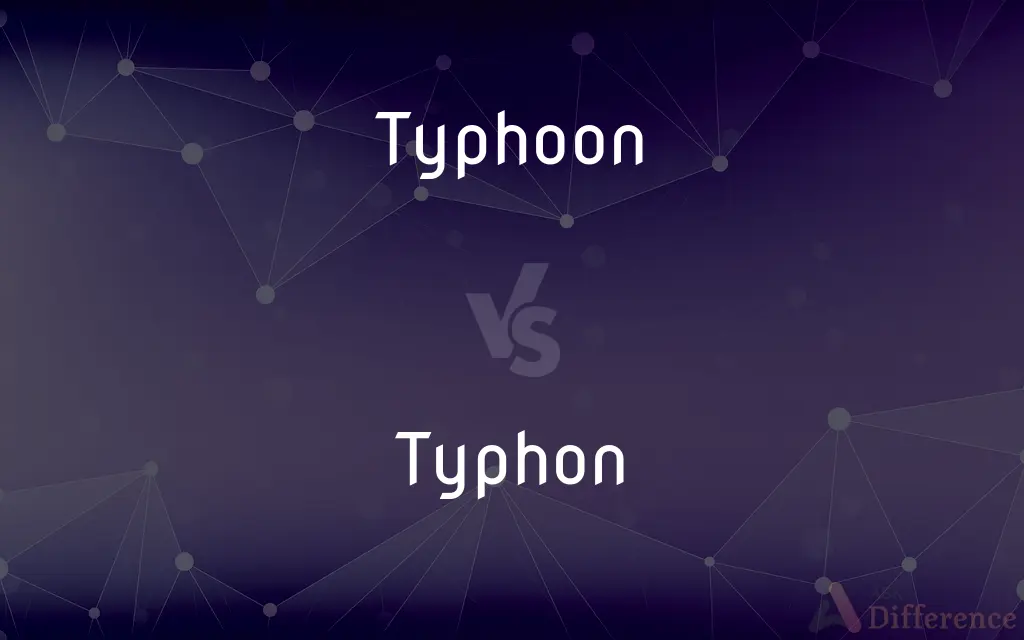Typhoon vs. Typhon — What's the Difference?
Edited by Tayyaba Rehman — By Fiza Rafique — Updated on May 1, 2024
A typhoon is a tropical cyclone occurring in the northwestern Pacific Ocean, characterized by strong winds and heavy rain, while Typhon in mythology is a monstrous giant associated with storms and volcanoes.

Difference Between Typhoon and Typhon
Table of Contents
ADVERTISEMENT
Key Differences
A typhoon is a meteorological term referring to a mature tropical cyclone that develops in the northwestern Pacific Ocean. Whereas Typhon, in Greek mythology, is depicted as a fearsome figure representing the destructive power of nature, often equated with storms and volcanic eruptions.
Meteorologically, a typhoon brings significant atmospheric disturbances, causing widespread damage due to wind, rain, and storm surges. On the other hand, Typhon's role in mythology is symbolic, embodying chaos and destruction, similar to the havoc wrought by natural disasters like typhoons.
Typhoons are classified based on their wind speeds and impact, and they play a key role in weather forecasting and disaster preparedness. Whereas Typhon, though not a real entity, influences cultural and literary representations of disaster and chaos, illustrating human attempts to personify natural threats.
The naming of typhoons follows a systematic approach involving a list pre-determined by meteorological organizations, aiding in public communication and safety measures. Conversely, Typhon's name and story vary slightly across different ancient texts, reflecting various cultural interpretations of this mythological figure.
Scientific understanding and monitoring of typhoons involve satellite imagery, weather stations, and ocean buoys to predict their path and intensity. In contrast, Typhon's description in myths involves hyperbolic and fantastical elements, such as spewing fire and having a massive size, highlighting the ancients' creative explanations for uncontrolled natural forces.
ADVERTISEMENT
Comparison Chart
Definition
A tropical cyclone in the northwest Pacific
A mythological giant linked to storms and volcanoes
Nature
Meteorological phenomenon
Mythological figure
Impact
Causes real damage and disruption
Symbolizes chaos and destruction
Measurement/Classification
Classified by wind speed and impact
Characterized through mythical narratives
Cultural/Scientific Relevance
Studied in the context of climate science
Featured in Greek mythology and literature
Compare with Definitions
Typhoon
Can lead to significant disasters.
The last typhoon resulted in widespread power outages.
Typhon
Symbol of chaos.
Typhon represents the natural forces of destruction and chaos.
Typhoon
Characterized by high winds.
The typhoon's winds exceeded 120 mph.
Typhon
Described as a giant.
Myths portray Typhon as a massive giant with serpents for legs.
Typhoon
A type of tropical cyclone.
The typhoon caused extensive flooding in the area.
Typhon
Defeated by Zeus.
In mythology, Zeus defeated Typhon and trapped him under a mountain.
Typhoon
Originates in the Pacific Ocean.
Each year, several typhoons form in the western Pacific.
Typhon
A figure from Greek mythology.
Typhon was considered one of the deadliest creatures in Greek myths.
Typhoon
Tracked by meteorologists.
Meteorologists are closely monitoring the approaching typhoon.
Typhon
Associated with storms and fire.
Typhon was said to breathe fire and cause violent storms.
Typhoon
A typhoon is a mature tropical cyclone that develops between 180° and 100°E in the Northern Hemisphere. This region is referred to as the Northwestern Pacific Basin, and is the most active tropical cyclone basin on Earth, accounting for almost one-third of the world's annual tropical cyclones.
Typhon
Typhon (; Greek: Τυφῶν, [typʰɔ̂ːn]), also Typhoeus (; Τυφωεύς), Typhaon (Τυφάων) or Typhos (Τυφώς), was a monstrous serpentine giant and one of the deadliest creatures in Greek mythology. According to Hesiod, Typhon was the son of Gaia and Tartarus.
Typhoon
A tropical cyclone occurring in the western Pacific or Indian Oceans.
Typhon
A monster with 100 heads, thrown by Zeus into Tartarus.
Typhoon
A weather phenomenon in the northwestern Pacific that is precisely equivalent to a hurricane, which results in wind speeds of 64 knots (118 km/h) or above. Equivalent to a cyclone in the Indian Ocean and Indonesia/Australia.
Typhon
(obsolete) A violent whirlwind; a typhoon.
Typhoon
(intransitive) To swirl like a hurricane.
Typhon
According to Hesiod, the son of Typhoeus, and father of the winds, but later identified with him.
Typhoon
A violent whirlwind; specifically, a violent whirlwind occurring in the Chinese seas.
Typhon
A violent whirlwind; a typhoon.
The circling typhon whirled from point to point.
Typhoon
A tropical cyclone occurring in the western Pacific or Indian oceans
Typhon
(Greek mythology) a monster with a hundred heads and one of the whirlwinds; son of Typhoeus and Echidna; father of Cerberus and the Chimera and the Sphinx
Common Curiosities
Can the impact of typhoons be predicted?
Yes, with modern meteorological technology, the path and potential impact of typhoons can be predicted with increasing accuracy.
What defines a typhoon meteorologically?
A typhoon is defined as a tropical cyclone with sustained winds of 74 miles per hour or more in the Northwest Pacific.
Who was Typhon in mythology?
Typhon was a monstrous giant in Greek mythology, often associated with causing violent storms and volcanic eruptions.
How does Typhon compare to other mythological creatures?
Typhon is often considered one of the most powerful and fearsome creatures in Greek mythology, comparable to other destructive figures like the Titans.
What scientific methods are used to study typhoons?
Typhoons are studied using satellite imaging, atmospheric pressure readings, and wind speed measurements to understand and predict their behavior.
How do typhoons affect human activities?
Typhoons can disrupt human activities significantly, causing evacuations, property damage, and sometimes loss of life due to their intense weather conditions.
What does Typhon symbolize in literature?
In literature, Typhon often symbolizes the chaotic and destructive forces of nature, similar to the real-world impacts of typhoons.
What preparations are typically made for an approaching typhoon?
Preparations for an approaching typhoon include securing property, preparing emergency kits, and heeding evacuation orders from authorities.
How do cultural interpretations of Typhon vary?
Cultural interpretations of Typhon vary, with some texts emphasizing his role as a destructor, while others focus on his defeat and imprisonment by Zeus, symbolizing the triumph of order over chaos.
Is Typhon represented in any modern media?
Typhon appears in various forms in modern media, often depicted in films, video games, and books that draw on Greek mythology.
Share Your Discovery

Previous Comparison
Belief vs. Faith
Next Comparison
Fundamental vs. BasicAuthor Spotlight
Written by
Fiza RafiqueFiza Rafique is a skilled content writer at AskDifference.com, where she meticulously refines and enhances written pieces. Drawing from her vast editorial expertise, Fiza ensures clarity, accuracy, and precision in every article. Passionate about language, she continually seeks to elevate the quality of content for readers worldwide.
Edited by
Tayyaba RehmanTayyaba Rehman is a distinguished writer, currently serving as a primary contributor to askdifference.com. As a researcher in semantics and etymology, Tayyaba's passion for the complexity of languages and their distinctions has found a perfect home on the platform. Tayyaba delves into the intricacies of language, distinguishing between commonly confused words and phrases, thereby providing clarity for readers worldwide.
















































